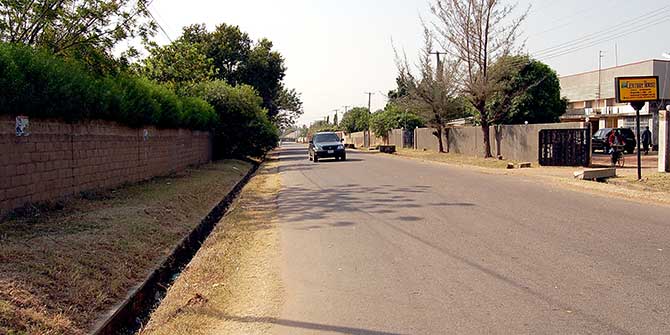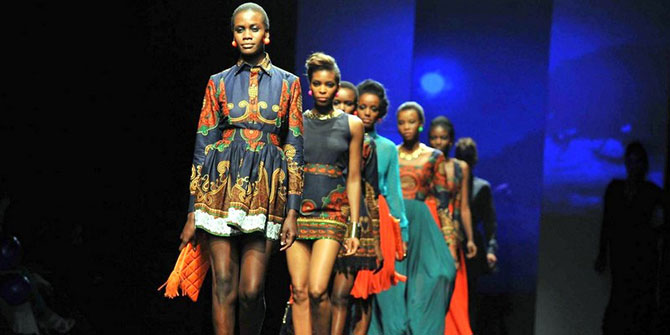Peter Chonka argues that the volume provides stimulating contributions that highlight the importance of changing media technologies in the ‘everyday’ lives of people on the African continent.
Featuring rich ethnographic and textual material – ranging from the phone use of Zanzibari hijabi ‘ninjas’ to a Zimbabwean tabloid’s take on the ‘Bulawayo penis prophet’ – the publisher’s generic series cover image does not do justice to this new volume on ‘everyday media culture in Africa’. Of course, one could argue that the bland cover removes the need to condense such a diverse range of cases and theoretical discussions into a single generalised (or exoticised) representation of media culture in Africa. As such, essentialised conceptualisations of African audiences are taken to task frequently throughout the book’s eleven chapters. In their introduction, editors Wendy Willems and Winston Mano critique dominant narratives of media use on the continent: the image of the ‘primitive’ user juxtaposed with the ‘modern’ tool (the tired Maasai-with-mobile-phone-isn’t-that-interesting! trope) or the notion that African audiences are passive recipients of ever increasing volumes of data and therefore more susceptible to the machinations of criminal, genocidal or ‘radicalised’ propagandists.
By refreshing contrast, the editors and contributors of this volume conceptualise Africa as a ‘vantage point’ from which dominant Western-derived ideas around media consumption and production can be ‘provincialised’. Instead of serving as a testing ground for theories honed in the West, African settings instead provide opportunities for researchers to conceptualise the multiple ways in which modern media production and consumption reflect and shape lives lived in and beyond the continent. The editors argue that the idea of media’s social embeddedness must go beyond the immediate context of consumption (the ‘living room’ as usually imagined in Western media studies) and engage with multiple and overlapping public and private spaces of media reception and deployment.
This theoretical framing is expanded on by Helle Valle’s chapter on a proposed ‘practice-ethnographic’ approach for defining and conceptualising ‘media culture’ in Africa. ‘Culture’ in this contribution is not used as a unified noun but is instead conceived of in terms of practice and uses. The chapter highlights the tension between studying the particularity of practices and the patterns that they generate and argues that they should be ‘analytically treated as interdependent parts of the same social reality’ (p.28). Helle Valle gives the contrasting examples of fashionable smartphone-equipped young people in cafés in the capital and the old lady with the dead mobile in the village to rhetorically ask if such individuals can be conceived of as being part of the same media ‘culture’. One could question whether there is anything distinctly ‘African’ about this juxtaposition, but perhaps that’s the point: ‘particularities’ of context matter, but not necessarily in terms of a distinction between ‘Africa’ and the ‘West’ (or elsewhere).
The following three chapters are thematically tied together through the changing role of the state in media production and new forms of mass consumption. Heinze’s historical overview of Zambian colonial and post-colonial broadcasting details debates over language use/non-use in state media. Media here becomes a site of contestation for different ethno-linguistic groups to assert their particular identity, paradoxically reaffirming the centrality of the media as a ‘national’ space.
Wasserman & Mbatha’s chapter on ‘tabloid’ TV in Zambia, and Mare’s discussion of tabloid newspapers in Zimbabwe both take critical aim at western prescriptions on the role of ‘good’ journalism for democratic life. The former claims to present a ‘descriptive rather than normative perspective’ (p.71) on the ways in which people relate to the emergence of private tabloid TV stations. These broadcasters focus on sensationalised human interest stories and privilege ‘ordinary’ voices in contrast to the dull political coverage of state news media. The writers argue that their analysis ‘can bring to light alternative public spheres where democratic life may flourish in ways unforeseen in elite media discourses’ (ibid). While one could argue that this in itself is simply another ‘normative’ take on the emancipatory potential of media, a potentially more interesting point concerns the use of terminology in the discussion of a Zambian media ‘mainstream’. ‘Mainstream’ in this discussion seems synonymous with ‘state’ media and is seen in opposition to an insurgent private tabloid broadcaster. Nonetheless, if (as the broadcaster claims) this tabloid news channel has a viewership of 84 per cent of Lusaka’s population (p.73) at what point can it be considered to be ‘mainstream’? What are the implications of this shift? This same tension is explicitly highlighted in Mare’s subsequent discussion of newspapers in Harare where the tabloid in question is itself state-owned. In both of these interesting chapters some broader international comparison (and not necessarily with the West) would be helpful to further contextualise some of these problematic and pejorative labels of elite/mass, tabloid/mainstream, state/private media production.
The following three contributions examine the ways in which media users engage with different forms of radio and online journalism from local and international producers. Freré’s cross-border study of audience perspectives of radio stations in the Great Lakes region demonstrates that despite significant investment by external donors for various agendas of ‘peace-building’, most consumers do not actually seem to be listening to such broadcasting. The chapter also emphasises the importance of local languages across the different borders and the fact that international broadcasters encounter obstacles related to listener preferences in trying to market regional mono-lingual programming.
Picking up the theme of international media, Abubakar’s contribution focuses on the BBC’s ‘digital quest’ in Nigeria. The chapter highlights the ‘convenient convergence’ (p.147) of multiple old and new media platforms (for instance the BBC’s use of social media to broadcast and promote content) and particular practices of media consumption in the African context, such as the prevalent use of mobile phones for radio listening. Echoing the editors’ introductory warning against overemphasising the free agency of the individual ‘prosumer’, Abubakar notes how audience participation can in itself be viewed as part of a broader ideological project by the BBC, whose institutional structures remain dominant in the media landscape. To develop this interesting discussion it would be useful to further elaborate on what this ideological agenda actually looks like in BBC multimedia programming, and how audiences respond, resist or reinterpret this through a range of platforms.
Avle’s chapter on Twitter ‘sociability’ vis-á-vis local radio in Ghana argues that ‘not all media participation is about politics or the state’ (p.175) and takes a much more fine-grained look at the mechanics of interactions between media producers and consumers. While the discussion is well executed, the style of the material used (often a profusion of @s #s and URLs) highlights some of the challenges inherent in contextualising and presenting a relatively small sample of social media-derived data.
The final three chapters take the most explicitly ethnographic approach in their discussion of relationships between media texts and technologies. Pype’s chapter focuses on the elderly, a social category rarely explored with regard to changing media technologies. The analysis moves beyond a ‘mere interpretative approach’ (p.213) – i.e. one that focuses solely on individuals’ self-representations, needs, wants etc. – to a discussion of the materiality and use of media devices such as mobile phones. The discussion details mobile phone practices among and between different generations in Kinshasa that both reflect and alter power relations in society.

Photo credit: Erik (HASH) Hersman via Flickr (http://bit.ly/2sCUIy6) CC BY 2.0
Unlike Pype who largely limits her discussion to the practices and uses of the phone, Schoon & Strelitz’s chapter on mixed race identities and mobile phones in small town South Africa, and Mutch’s contribution on young veiled women and digital media in Zanzibar, also incorporate discursive analysis of media. The methodological challenges of disentangling a complex array of influences and practices become apparent here. Sufficient contextualisation of certain websites, for instance, within the wider discussion of mobile phones as facilitators of complex practices of ‘self creation’ is evidently difficult. Nonetheless, Schoon & Strelitz’s chapter succeeds in highlighting the often contradictory ways in which ubiquitous mobile technologies enable multiple forms of social openness, ‘mixing’, and ostracisation.
Similarly, Mutch’s discussion grapples with the complexity of ‘agency behind the veil’ and the multiple ways in which information technology can be used by individuals in private and public spaces structured by strong societal pressures. The deployment of Mahmood’s (2006) challenge to liberal theorising about resistance and empowerment is useful here, although the multiple issues and influences on these young women’s lives (and their specific connections with media technologies) makes for a sometimes convoluted analysis of ‘agency’. The ambition of this project is epitomised in long sub-headings such as ‘Being Muslim, Being Modern, Being Zanzibari, Being Ninja’, and elsewhere the narrative jumps back and forth, particularly with regard to informants’ discussions of sex. An apparent typo (p.230) confusing haram and halal activities does not help with clarity here either. Nonetheless, interesting material abounds here and the chapter highlights how media technologies feature in (and help inform) the ‘performance’ of sexuality in this particular context.
All of the contributions to this stimulating volume highlight the importance of changing media technologies in the ‘everyday’ lives of people on the continent. There are theoretical contributions to the broader field of media studies here that deserve attention from audiences not just focused on Africa. Indeed, that’s the only way in which the stated goal of internationalising and decolonising the broader field will be achieved.
Everyday Media Culture in Africa: Audiences and Users. Wendy Willems and Winston Mano eds. Routledge, New York. 2017.
Peter Chonka is a PhD Candidate at the University of Edinburgh’s Centre of African Studies and a Teaching Fellow at SOAS.
The views expressed in this post are those of the author and in no way reflect those of the Africa at LSE blog or the London School of Economics and Political Science.





